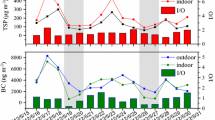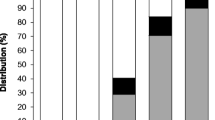Abstract
In school environments, children are constantly exposed to mixtures of airborne substances, derived from a variety of sources, both in the classroom and in the school surroundings. It is important to evaluate the hazardous properties of these mixtures, in order to conduct risk assessments of their impact on children’s health. Within this context, through the application of a maximum cumulative ratio approach, this study aimed to explore whether health risks due to indoor air mixtures are driven by a single substance or are due to cumulative exposure to various substances. This methodology requires knowledge of the concentration of substances in the air mixture, together with a health-related weighting factor (i.e. reference concentration or lowest concentration of interest), which is necessary to calculate the hazard index. Maximum cumulative ratio and hazard index values were then used to categorise the mixtures into four groups, based on their hazard potential and therefore appropriate risk management strategies. Air samples were collected from classrooms in 25 primary schools in Brisbane, Australia. Analysis was conducted based on the measured concentration of these substances in about 300 air samples. The results showed that in 92 % of the schools, indoor air mixtures belonged to the ‘low concern’ group, and therefore, they did not require any further assessment. In the remaining schools, toxicity was mainly governed by a single substance, with a very small number of schools having a multiple substance mix which required a combined risk assessment. The proposed approach enables the identification of such schools and thus aids in the efficient health risk management of pollution emissions and air quality in the school environment.



Similar content being viewed by others
References
AFSSET (2009) Procedure de qualification des emissions de composes organiques volatils par les materiaux de construction et products de decoration—rapport d'expertise collective. French Agency for Environmental and Occupational Health Safety, France
AgBB- Committee for Health-Related Evaluation of Building Products (2012) Evaluation procedure for volatile organic compound emissions (VOC and SVOC) from building products. Umweltbundesamt,Berlin http://www.umweltbundesamt.de/sites/default/files/medien/355/dokumente/agbb evaluation scheme 2012.pdf . Accessed on 5 Nov 2011
Billionnet C, Sherrill D, Annesi-Maesano I (2012) Estimating the health effects of exposure to multi-pollutant mixture. Ann Epidemiol 22(2):126–141
Crump DR, Dengel A, Swainson M (2009) Indoor air quality in highly energy efficient homes—a review. NHBC Foundation report. IHS BRE Press, Bracknell
Crump DR, Harrison BTP, De Brouwere K, Arvantis A, Cornelis C, Jantunen M, Price P, Torfs R (2013) An investigation of European data sets to determine their suitability for assessment of the health risk of mixtures by the MCR approach. Annual UK review meeting on outdoor and indoor air pollution research, Cranfield University
De Brouwere K, Cornelis C, Arvanitis A et al (2014) Application of the maximum cumulative ratio (MCR) as a screening tool for the evaluation of mixtures in residential indoor air. Sci Total Environ 479:267–276
EC- European Commission (2009) State of the art report on mixture toxicity. http://ec.europa.eu/environment/chemicals/effects/pdf/report_mixture_toxicity.pdf Accessed on 5 Nov 2011
ECA (2013) Harmonisation framework for health based evaluation of indoor emissions from construction products in the European Union using the EU-LCI concept. Urban Air, Indoor Environment and Human Exposure. European Commission, Luxemborg
ISO 16000–6 (2011) Indoor air—part 6: determination of volatile organic compounds in indoor and test chamber air by active sampling on Tenax TA sorbent, thermal desorption and gas chromatography using MS/FID, Berlin, Beuth Verlag
Jantunen MJ, Hanninen O, Katsouyanni K et al (1998) Air pollution exposure in European cities: the "EXPOLIS" study. J Expo Anal Environ Epidemiol 8(4):495–518
Johns DO, Wickers Stanek L, Walker K et al (2012) Practical advancement of multipollutant scientific and risk assessment approaches for ambient air pollution. Environ Health Perspect 120(9):1238
JRC (2005) Critical appraisal of the seting and implementation if inddor exposure limits in the EU—the INDEX project. Joint Research Centre-European Commission, Italy
Könemann H (1981) Fish toxicity tests with mixtures of more than two chemicals: a proposal for a quantitative approach and experimental results. Toxicology 19(3):229–238
Meek M, Boobis AR, Crofton KM et al (2011) Risk assessment of combined exposure to multiple chemicals: a WHO/IPCS framework. Regul Toxicol Pharmacol 60(2 suppl 1):S1–S14
Mishra N, Bartsch J, Ayoko GA et al. (2014) Volatile organic compounds: characteristics, distribution and sources in urban schools. Atmos Environ
Mølhave L, Clausen G, Berglund B et al (1997) Total volatile organic compounds (TVOC) in indoor air quality investigations*. Indoor Air 7(4):225–240
Price PS, Han X (2011) Maximum cumulative ratio (MCR) as a tool for assessing the value of performing a cumulative risk assessment. Int J Environ Res Publ Health 8(6):2212–2225
Price P, Han X, Junghans M et al (2012) An application of a decision tree for assessing effects from exposures to multiple substances to the assessment of human and ecological effects from combined exposures to chemicals observed in surface waters and waste water effluents. Environ Sci Eur 24(1):1–13
Salthammer T (2011) Critical evaluation of approaches in setting indoor air quality guidelines and reference values. Chemosphere 82(11):1507–1517
Salthammer T (2014) Very volatile organic compounds (VVOCs)- an understudied class of indoor pollutants
Sarigiannis DA, Hansen U (2012) Considering the cumulative risk of mixtures of chemicals—a challenge for policy makers. Environ Heal 11(Suppl 1):S18
Sarigiannis DA, Karakitsios SP, Gotti A et al (2011) Exposure to major volatile organic compounds and carbonyls in European indoor environments and associated health risk. Environ Int 37(4):743–765
SCHER (2007) Opinion on risk assessment on indoor air quality, 29 May 2007
Sexton K (2012) Cumulative risk assessment: an overview of methodological approaches for evaluating combined health effects from exposure to multiple environmental stressors. Int J Environ Res Publ Health 9(2):370–390
Acknowledgments
This work was supported by the Australian Research Council (ARC), QLD Department of Transport and Main Roads (DTMR) and QLD Department of Education, Training and Employment (DETE) through Linkage Grant LP0990134 and the 2014 ATN-DAAD Joint Research Co-operation Scheme (2013001344). Our particular thanks go to R. Fletcher (DTMR) and B. Robertson (DETE) for their vision regarding the importance of this work. We would also like to thank Prof. G. Marks, Dr. P. Robinson, Prof. K. Mengersen, Prof. Z. Ristovski, Dr. M. Mazaheri, Dr. C. He, Dr. G. Johnson, Dr. R. Jayaratne, Dr. S. Low Choy, Prof. G. Williams, W. Ezz, F. Salimi, L. Crilley, S. Clifford, M. Mokhtar, R. Laiman, L. Guo, Prof. C. Duchaine, Dr. H. Salonen, Dr. X. Ling, Dr. J. Davies, Dr. L. Leontjew Toms, F. Fuoco, Dr. A. Cortes, Dr. B. Toelle, A. Quinones, P. Kidd and E. Belousova, Dr. M. Falk, Dr. F. Fatokun, Dr. J. Mejia, Dr. D. Keogh, R. Appleby and C. Labbe for their contribution to the UPTECH project.
Compliance with ethical standards
The authors declare that the research did not involve any human participants nor animals.
Conflict of interest
The authors declare that there are no conflicts of interest (financial or non-financial).
Author information
Authors and Affiliations
Corresponding author
Additional information
Responsible editor: Constantini Samara
Electronic supplementary material
Below is the link to the electronic supplementary material.
ESM 1
(DOCX 336 kb)
Rights and permissions
About this article
Cite this article
Mishra, N., Ayoko, G.A., Salthammer, T. et al. Evaluating the risk of mixtures in the indoor air of primary school classrooms. Environ Sci Pollut Res 22, 15080–15088 (2015). https://doi.org/10.1007/s11356-015-4619-z
Received:
Accepted:
Published:
Issue Date:
DOI: https://doi.org/10.1007/s11356-015-4619-z




